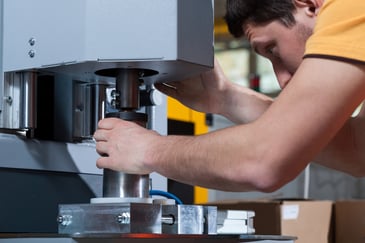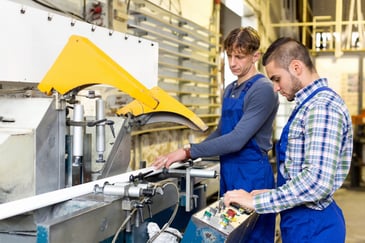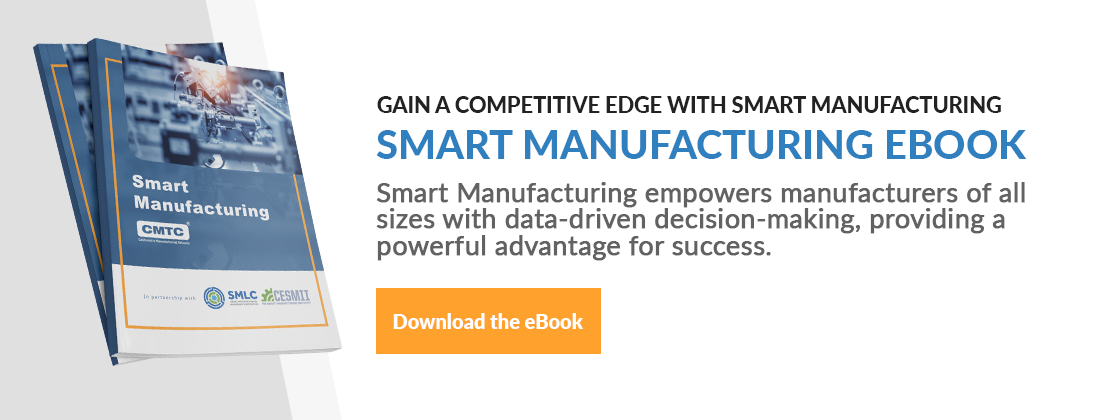September 24, 2015 | Smart Manufacturing
Smart Manufacturing Requires a New Kind of Workforce (Part 4 of 6)
This post is the fourth installment regarding the concept of Smart Manufacturing (SM). This series aims to inform manufacturers of SM’s components, how it affects business productivity, economics and plans, its importance in the value chain, how it changes the workforce and the future of manufacturing overall. This series is written in conjunction with the Smart Manufacturing Leadership Coalition (SMLC).
If you missed the previous blogs, click on the following links: Part 1A, Part 1B, Part 2 and Part 3.
Revitalizing the Manufacturing Workforce
Manufacturing, in general, faces challenges in securing the necessary educated, trained workforce needed to be successful. Contributing factors include an increase in emerging technologies, retirements, and fewer young people interested in manufacturing careers. Recognizing that these challenges directly impact their bottom line, employers are stepping up their workforce development programs to implement targeted, scalable solutions. Smart Manufacturing is part of those scalable solutions.
Smart Manufacturing will not only lead to increased productivity, efficient operations, sustainability and product innovation but will also bring about beneficial changes to the existing and future workforce. In fact, adding more technology to the production floors can mean two things.

One, current employees will require additional education and training in order to fully maximize the potential and ROI of the new technology. Employers must first know existing proficiencies of their current workforce in order to develop the new competencies required.
Then, training modules, new educational curricula, smart design standards and effective learner interfaces can be developed to create a flexible, dynamic workforce skilled in SM techniques and provide pathways for continuous learning.
And two, new and emerging technology in the manufacturing industry will help attract the next-generation workforce that is very comfortable with using web tools, rapidly evolving technology and the world of Big Data. SM can be the key to reinvigorating the manufacturing workforce, attracting and nurturing a younger talent pool that historically may not have considered a career choice in the manufacturing industry.
First, let’s talk about the new focus areas that may arise with the implementation of Smart Manufacturing.
Future Manufacturing Careers
As the overall concept and blueprint of Smart Manufacturing continues to develop, the future looks bright for manufacturers who decide to embark on the SM path.
Once manufacturers embark on their journey to implement SM technologies, they will recognize the changes they need to make to achieve their optimum manufacturing operational strategy and meet performance and productivity requirements. New positions and capabilities are likely to emerge.
“Smart Manufacturing leverages the increasing amounts of information coming from Internet of Things capable devices. Every day we see the impact of new, improved or emerging technologies. Our challenge is to grab a hold of these new capabilities in ways that make sense to us and improve our lives.
The same thing is happening in our factories. What new technologies do we adopt and implement so that we can maximize the impact they have on our production capabilities? An educated, skilled and motivated workforce in an SM environment is necessary to help make these important decisions and take advantage of the new tools,” explains Pam Hurt, Workforce Development Industry Manager at SME.
As far as future careers go, any position that is able to leverage information within a manufacturing facility will become increasingly valuable. Analytics and data management will become additional requirements for new manufacturing positions as these skills will become highly desirable to achieve SM.
“The richer the information, the more useful it becomes to everyone in the organization. At the end of it all, a high-functioning SM environment is defined by the valuable and accurate content employees contribute to the digital thread,” explains Hurt.
Skills development, resource tools and techniques are needed to better integrate human factors and decisions into smart software tools. This integration would enable faster, more disciplined decision-making on the plant floor and allow operators to become “knowledge” workers.

With a New Type of Manufacturing Comes New Responsibilities
While a common concern for those unfamiliar with Smart Manufacturing is that their facility may have to expand their workforce and hire new tech-savvy employees, this is not necessarily true. This is why the SMLC and its partners are researching heavily to identify existing or create new educational resources for current manufacturing employees.
Rather than adding a new department or bringing on new hires to your company, SM may bring about change in the form of existing jobs that transition to using new technologies as companies adopt new practices.
“Creating specialist roles may be appropriate in some situations, but it may be expensive and difficult to separate the traditional skill sets required in manufacturing from old to new roles,” explains Hurt.
“More than likely, we will see the emergence of blended hybrid job functions that may require enhanced collaborative communication and problem-solving skills to properly apply the new tools for benefit.”
Some of these new, blended job functions include managing data analytics, tracking products in the value chain using wireless devices (cell phones, tablets, etc.) and being able to pinpoint issues in the supply chain quickly should they occur.
While the headcount can remain the same, SM adds new duties that can help the production of your manufacturing material. Think of it like a smartphone application. “Cell phone users are not necessarily concerned about how an app was created, but rather need to decide which apps improve and enhance their experience [while] using the device.”

Welcome Millennials to the Manufacturing Sector
Making such technological strides in a traditional industry opens the doors for a new demographic to enter your workforce — millennials.
Smart Manufacturing can bridge the gap between career choices and demographics to revitalize the industry. Millennials, with their tech-savvy abilities, creative-solution mindset, and eagerness to contribute, can quickly grasp and implement SM apps, capitalize on new opportunities, and increase productivity.
Of course, new millennial hires will be integrated into their roles with an understanding of the company’s specific goals, manufacturing expertise and job duties. “However, rather than emphasizing what and how they should perform on the job, companies should focus on the challenges, desired outcomes, and expected results.
Allowing new employees to bring their ideas to the table and exploring the SM landscape with leadership support and recognition could result in higher employee satisfaction, increased productivity and better job performance,” explains the SME.
Attracting and integrating the millennials is not just a single effort. SMLC members have a variety of programs, products and services that directly target these students as they prepare to enter the workforce. SME targets high schools, community colleges and universities, including conferences, research endeavors and scholarship opportunities through a variety of initiatives.
An example is the PRIME program (Partnership Response in Manufacturing Education), an initiative that aims to build a network of industry, education and association partners that collaborate to help improve the quality of advanced manufacturing education in high schools on a local level.
With the combination of these initiatives and the natural affinity towards today’s technology, the inclusiveness of millennials in manufacturing can flip the industry on its head — for the better.
“Companies embracing Smart Manufacturing will have a dynamic, flexible environment. And the workforce will match that as long as we prepare them. As the new generation comes on board, they will help drive the transition for everyone to a more digitally capable workforce able to apply and use the advanced tools to operate the new technologies.”
Supporting the Next Generation Workforce
Before a company invests in new technology, its leadership must clearly define its business goals and objectives and map out the expectations of its workforce. The changes that SM will bring depend on the individual business goals of the manufacturer.
Factors such as the rate of technology expansion and the time invested in training boil down to just how fast a manufacturer wants to (and is capable of) do so — making SM not a race but rather a growth-based initiative with clear deliverables and expected outcomes.
The competitive advantage of a company is often the reflection of a successfully trained and skilled workforce. In the manufacturing sector, both the current and future workforce are able to take advantage — take it from SME:
“The current workforce can enhance their existing skills by taking advantage of advanced training that can be applied on the job seamlessly when new apps and processes enter the marketplace. With the development of new skills, this workforce will become more efficient, ultimately resulting in increased productivity.”
Resources such as Tooling U-SME provide comprehensive learning services that feature direct engagement with both companies and schools. A variety of delivery mechanisms are available for the education and training needed by companies and include online classes, instructor-led training, pre/post assessments, certifications, custom content and digital books and videos. The goal is to provide the current workforce with more “flexible and agile forms of learning.” In short, a good amount of on-the-job training can be accomplished on an employee’s own timetable.
Furthermore, joining organizations such as the SMLC has benefits of seamlessly helping the workforce adjust to the changing work atmosphere. For instance, one’s membership allows early-adopting companies to share their best educational and training practices should a manufacturer have trouble trying to educate their workforce.
“Future manufacturing talent will benefit from educational programs that adhere to industry standards. Collaborations between academia, manufacturing companies and industry organizations help build communities of skilled workers to meet the growing technical capabilities required today and in the years ahead,” encourages Hurt.
The Biggest Change is in People — not Technology
A major part of seeing success early has to do with the company culture and the commitment of team members. It’s important to remember that all the integration and use of technology is rendered useless if it is combined with employees who don’t fully understand how it will make their job easier, not harder. And just as crucial as employee support is needed for a successful SM path, it can also serve as the biggest hurdle in SM implementation.
“For us, [the biggest hurdle] wasn’t technology. It wasn’t capabilities. It was changing what people did every day when they came into work,” explains Jim Wetzel, Director of Global Reliability at General Mills and Chairman of SMLC.
“Instead of saying ‘I’m going to go on gut feeling‘ — to saying ‘I’m going to see what this information says and I’m going to use that as my guiding light. I’m going to let statistics guide my actions.’”
As Smart Manufacturing is often discussed in terms of technology and innovation, Wetzel warns otherwise. “Technology is the enabler. It’s not all about technology. The true challenge is getting people to behave differently.”
Contributors to this blog post included Pam Hurt, Workforce Development Industry Manager at SME and Jim Wetzel, Director of Global Reliability at General Mills and Chairman of SMLC.

